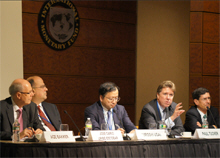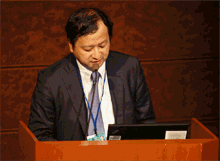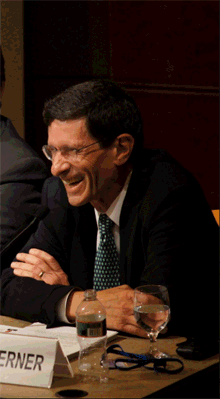
Typical street scene in Santa Ana, El Salvador. (Photo: iStock)
IMF Survey: Regulators Identify Data Needs to Track Shadow Banks
September 29, 2011
- Firms doing bank-like activities outside banking system can pose systemic threat
- Such shadow banking operations have grown dramatically
- Regulators need more, different data to understand fast-changing sector
In the wake of the global financial crisis, regulators agree that they need to know more about the shadow banking sector, a panel discussion on the sidelines of the 2011 IMF–World Bank Annual Meetings heard.

Shadow banking panel (from l): Bakker, Uribe, Ugai, Tucker, Berner. Shadow banks do many things banks do, but outside regular banking system (IMF photo)
NONBANK FINANCIAL INSTITUTIONS
Participants at a September 23 panel, “Casting Light on Shadow Banking: Data Needs for Financial Stability,” recalled that bank-like activities carried out by nonbank financial institutions in the U.S. mortgage market were the catalyst for the biggest global financial crisis since the Great Depression.
Yet they noted that risk that these so-called shadow banks—such as insurance companies, money market funds, hedge funds and investment banks—took on, and the implications for the stability of the financial system, were not well understood, even though their activities were expanding sharply.

Colombia’s central bank Governor Jose Dario Uribe: outside regular banking system, prudential regulatory standards are less formally applied (IMF photo)
For example, in the decade before the 2007 breakdown in the U.S. mortgage market, shadow banking liabilities in the United States quadrupled, “growing all out of proportion to the liabilities in traditional banks,” Richard Berner, Counselor to the U.S. Treasury Secretary, told the panel.
Much the same as banks
Firms engaged in shadow banking do many of the same things as banks—such as gathering funds from those with money to invest and lending those funds to borrowers, or transforming short-term funds into long-term assets. In other words, like banks, they intermediate between those with money and those who want to borrow it. But they do so “outside the regular banking system … in an environment where prudential regulatory standards are either not applied or less formally applied,” according to José Dario Uribe, Governor of Colombia’s central bank, Banco de la República.
Moreover, there is not a clean separation between traditional banking and the rest of the financial sector. Banks often provide financing to securities firms and other nonbank financial institutions carrying out bank-like activities.

Bank of England Deputy Governor Paul Tucker: ‘Regulatory arbitrage is endemic and it’s impossible to push that tide back’ (IMF photo)
Shadow banking will continue to grow, said Paul Tucker, Deputy Governor for Financial Stability of the Bank of England. Borrowers and lenders will seek out less heavily regulated, and therefore often cheaper, venues. “Regulatory arbitrage is endemic and it’s impossible to push that tide back in a world where capital is free to flow across borders and freedom has become one of the great values of the age.”
Shining a light
In the wake of the global financial crisis, regulators agree that they need to know more about the shadow banking sector and how it works. Shadow banks engage in activities “pretty close to the plumbing of the financial system,” Tucker said, but they lay “below the threshold of interest of most policymakers until things go wrong, when suddenly they discover a burning interest.”
Traditional balance sheet data—a snapshot of a firm’s liabilities and assets—from shadow banks is essential, panelists agreed. But authorities need more.
“Compared to banking, it is more difficult to understand where and how the risks of shadow banking could materialize,” said Hiroshi Ugai, Director-General of the International Department at the Bank of Japan.

Bank of Japan’s Hiroshi Ugai: ‘Compared to banking, it is more difficult to understand where and how risks of shadow banking could materialize’ (IMF photo)
Traditional data must be supplemented by market data, he said, such as market surveys that indicate the direction in which shadow banks may be heading and intelligence from supervisors—including securities or insurance regulators who often have primary responsibility for the financial firms involved in shadow banking.
Panel moderator Age Bakker, the departing IMF Executive Director for the Netherlands, said several international efforts could provide more insight on the coverage of nonbank financial institutions in economic and financial statistics. The IMF and the Financial Stability Board, for example, are implementing a joint initiative for the Group of 20 advanced and emerging economies to address gaps in the data.
Informal blend
The shadow banking system is an informal blend of markets that include those for securities that are backed by assets, for derivatives that insure against the default of securities and loans, and for repurchase agreements (short-term borrowing using securities as collateral).
The U.S. Treasury’s Berner said authorities want to identify who sells the credit and liquidity insurance derivatives designed to reduce liquidity risk, the terms of credit that gets extended in the shadow system, the terms of repurchase agreement financing (including how the securities are valued for collateral purposes) and who are the parties on each side of shadow transactions. And standardized data collection is essential—so the information can be analyzed across markets and across countries.

U.S. Treasury’s Richard Berner: standardized data collection is essential—so that information can be analyzed across markets, across countries (IMF photo)
Moreover, Ugai noted, data gathering is further complicated because “the shadow banking system will change faster than the traditional banking system.”
During the beginning of the last decade, for example, it would have been useful to identify the extent to which shadow banking activities that funded long-term assets such as mortgages with short-term liabilities were dependent upon financing from banks, Tucker said. But “there’s not much of that now,” he added. Authorities may identify a problem and follow it up only to see it fade away while “some other manifestation of the risks pops up. The economics of this is hellishly easier than turning it into anything operational.”
The bottom line, Berner concluded, is that “we need better analytical frameworks. We need better data to assess those threats to financial stability. Both—combined with the insights and the intelligence we derive from oversight and supervision, as my colleagues have indicated—are essential inputs to identify and mitigate the threats that we see to financial stability.”







